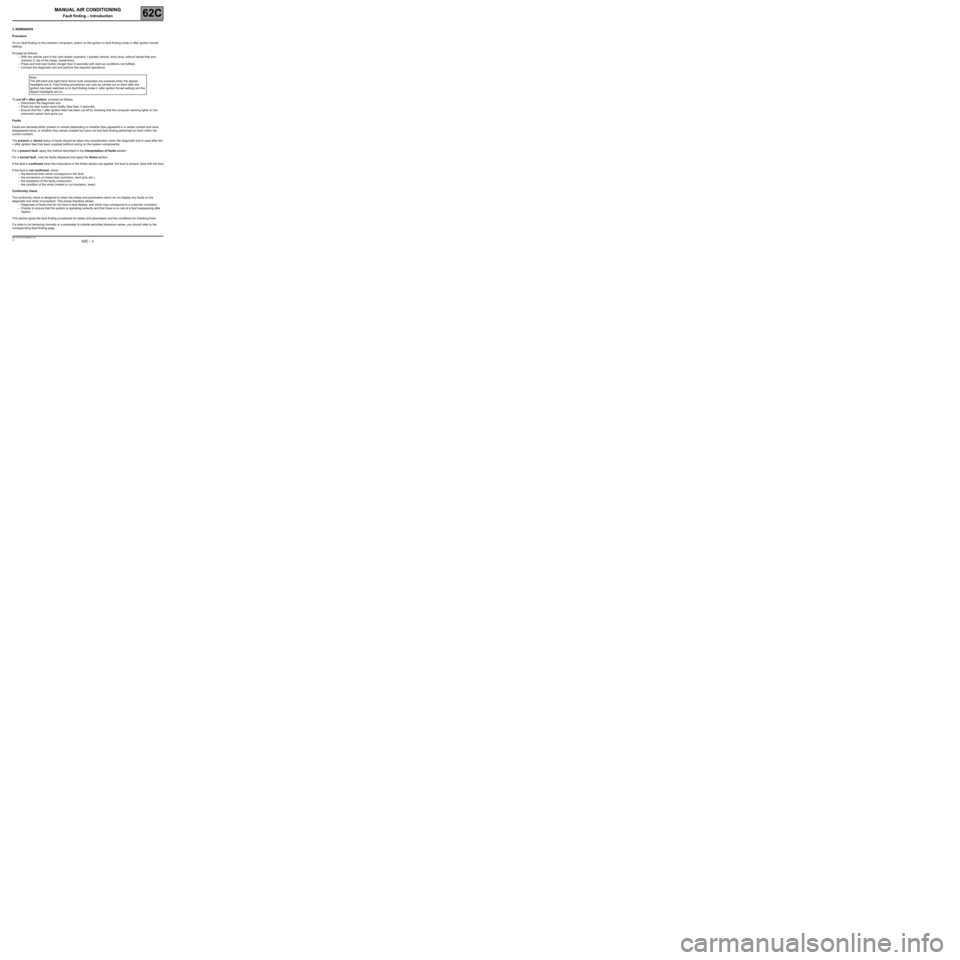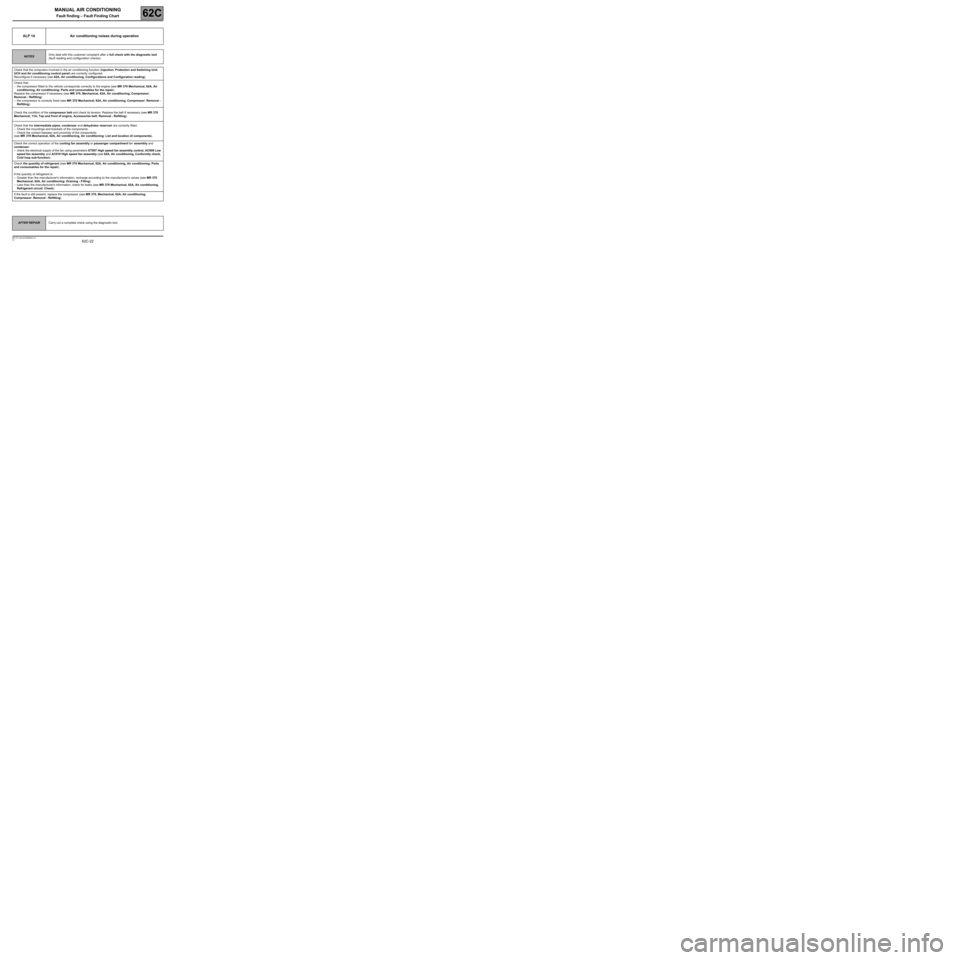ESP RENAULT SCENIC 2009 J84 / 2.G Air Conditioning Manual Conditioning Workshop Manual
[x] Cancel search | Manufacturer: RENAULT, Model Year: 2009, Model line: SCENIC, Model: RENAULT SCENIC 2009 J84 / 2.GPages: 23
Page 3 of 23

62C - 3
MANUAL AIR CONDITIONING
62C
V2 MR-372-J84-62C000$010.mif
262CMANUAL AIR CONDITIONING
Fault finding – Introduction
3. REMINDERS
Procedure
To run fault finding on the vehicle's computers, switch on the ignition in fault finding mode (+ after ignition forced
setting).
Proceed as follows:
–With the vehicle card in the card reader (scenario 1 keyless vehicle, entry level, without hands-free and
scenario 2, top of the range, hands-free),
–Press and hold start button (longer than 5 seconds) with start-up conditions not fulfilled,
–Connect the diagnostic tool and perform the required operations.
To cut off + after ignition, proceed as follows:
–Disconnect the diagnostic tool,
–Press the start button twice briefly (less then 3 seconds),
–Ensure that the + after ignition feed has been cut off by checking that the computer warning lights on the
instrument panel have gone out.
Faults
Faults are declared either present or stored (depending on whether they appeared in a certain context and have
disappeared since, or whether they remain present but have not had fault finding performed on them within the
current context).
The present or stored status of faults should be taken into consideration when the diagnostic tool is used after the
+ after ignition feed has been supplied (without acting on the system components).
For a present fault, apply the method described in the Interpretation of faults section.
For a stored fault, note the faults displayed and apply the Notes section.
If the fault is confirmed when the instructions in the Notes section are applied, the fault is present. Deal with the fault
If the fault is not confirmed, check:
–the electrical lines which correspond to the fault,
–the connectors on these lines (corrosion, bent pins, etc.),
–the resistance of the faulty component,
–the condition of the wires (melted or cut insulation, wear).
Conformity check
The conformity check is designed to check the states and parameters which do not display any faults on the
diagnostic tool when inconsistent. This phase therefore allows:
–Diagnoses of faults that do not have a fault display, and which may correspond to a customer complaint.
–Checks to ensure that the system is operating correctly and that there is no risk of a fault reappearing after
repairs.
This section gives the fault finding procedures for states and parameters and the conditions for checking them.
If a state is not behaving normally or a parameter is outside permitted tolerance values, you should refer to the
corresponding fault finding page.Note:
The left-hand and right-hand Xenon bulb computers are powered when the dipped
headlights are lit. Fault finding procedures can only be carried out on them after the
ignition has been switched on in fault finding mode (+ after ignition forced setting) and the
dipped headlights are on.
Page 22 of 23

MANUAL AIR CONDITIONING
Fault finding – Fault Finding Chart62C
62C-22V2 MR-372-J84-62C000$040.mif
ALP 14 Air conditioning noises during operation
NOTESOnly deal with this customer complaint after a full check with the diagnostic tool
(fault reading and configuration checks).
Check that the computers involved in the air conditioning function (Injection, Protection and Switching Unit,
UCH and Air conditioning control panel) are correctly configured.
Reconfigure if necessary (see 62A, Air conditioning, Configurations and Configuration reading).
Check that:
–the compressor fitted to the vehicle corresponds correctly to the engine (see MR 370 Mechanical, 62A, Air
conditioning, Air conditioning: Parts and consumables for the repair).
Replace the compressor if necessary (see MR 370, Mechanical, 62A, Air conditioning, Compressor:
Removal - Refitting).
–the compressor is correctly fixed (see MR 370 Mechanical, 62A, Air conditioning, Compressor: Removal -
Refitting).
Check the condition of the compressor belt and check its tension. Replace the belt if necessary (see MR 370
Mechanical, 11A, Top and front of engine, Accessories belt: Removal - Refitting).
Check that the intermediate pipes, condenser and dehydrator reservoir are correctly fitted.
–Check the mountings and brackets of the components.
–Check the contact between and proximity of the components.
(see MR 370 Mechanical, 62A, Air conditioning, Air conditioning: List and location of components).
Check the correct operation of the cooling fan assembly or passenger compartment fan assembly and
condenser:
–check the electrical supply of the fan using parameters ET007 High speed fan assembly control, AC009 Low
speed fan assembly and AC010 High speed fan assembly (see 62A, Air conditioning, Conformity check,
Cold loop sub-function).
Check the quantity of refrigerant (see MR 370 Mechanical, 62A, Air conditioning, Air conditioning: Parts
and consumables for the repair).
If the quantity of refrigerant is:
–Greater than the manufacturer's information, recharge according to the manufacturer's values (see MR 370
Mechanical, 62A, Air conditioning: Draining - Filling).
–Less than the manufacturer's information, check for leaks (see MR 370 Mechanical, 62A, Air conditioning,
Refrigerant circuit: Check).
If the fault is still present, replace the compressor (see MR 370, Mechanical, 62A, Air conditioning,
Compressor: Removal - Refitting).
AFTER REPAIRCarry out a complete check using the diagnostic tool.